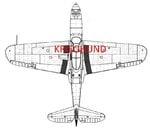Shortround6
Lieutenant General
The P-39 was (to begin with) an 1100hp fighter. the P-38 was a 2200HP fighter and the Seversky/Republic designs, once you get passed the the P-43, were going to be 1400-2000HP fighters. the 1400HP version was superseded by the 2000HP version.
The P-38 and the P-47 had enough power to bull their way through at low altitude in spite of the turbo equipment.
If you enlarge the P-39 to include an effective inter-cooler and two stage supercharger AND more fuel, you have increase weight, bulk and drag and yet have NOT increased power below 15,000ft.
And, as in many things, timing is everything.
With 939 P-39s built by the end of 1941 compared to ONE P-47 and with the totals at the the end of 1942 running 2871 to 533 delaying production of the P-39 by even a few months would have put the US in an even worse situation than it found it self in. The Extra time take to get the the turbos "right" meant that the P-38 and the P-47 were not available until a bit later time frame.
The P-38 and the P-47 had enough power to bull their way through at low altitude in spite of the turbo equipment.
If you enlarge the P-39 to include an effective inter-cooler and two stage supercharger AND more fuel, you have increase weight, bulk and drag and yet have NOT increased power below 15,000ft.
And, as in many things, timing is everything.
With 939 P-39s built by the end of 1941 compared to ONE P-47 and with the totals at the the end of 1942 running 2871 to 533 delaying production of the P-39 by even a few months would have put the US in an even worse situation than it found it self in. The Extra time take to get the the turbos "right" meant that the P-38 and the P-47 were not available until a bit later time frame.

